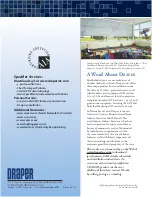
Shade Fabric Selection Based on Building Position and Location
Openness Factor By Region
Regions
Clear View
Obstructed View
A
B
C
D
10%
3%
5%
5%
10%
5%
10%
10%
10%
3%
5%
5%
5%
5%
3%
3%
10%
5%
5%
5%
5%
5%
3%
3%
10%
10%
5%
5%
10%
5%
10%
10%
The compass below
indicates the recom-
mended openness
factor based on the
orientation of your
building.
��������
�������
��������
���������
�������
�����������
������
�������
�������
����������
������
���
�������
�����
�����������
�����������
�������������
�������
��������������
���
���������
���������
�������
�
�
�
�
W
E
N
S
Fabric Openness Factor
The following key identifies four properties of shade fabrics and openness factors. Normally, dark colors provide better glare control because they
absorb light. Light colors offer better heat control because they reflect heat. Duplex fabrics offer both glare control and heat control. All
Draper
fabrics are fire retardant. Complete fabric lines and fire retardant ratings available at
www.draperinc.com/go/ShadeFabric.htm.
Natural light can be beneficial to health in the working environment. Ensuring protection against glare and reflection is essential when choosing
window shade fabric openness. Openness selection should be based on building position, geographical location or exposure area, office activity,
and view: clear or obstructed.
Use the charts below to make recommendations for window shade openness factor to control glare and work station reflections, for UV protection
and for better view-through capabilities.
Openness factor is the
percentage of openness of
the solar woven fabrics. The
openness factor determines
how much light, heat and
glare the fabric will allow to
enter. The openness factor
also determines how much
of an outward (and inward)
view fabric will allow.
Shade fabric color selected,
building orientation,
and artificial and natural
lighting will affect see-
through capability.
3%
Openness
5%
Openness
10%
Openness
Fenestration Data
Draper
offers test data for the specifier’s use in controlling light and heat, view and privacy, and glare level.
•
Solar transmittance (T
S
), reflectance (R
S
), and absorptance (A
S
)
add up to 100%, indicating that all the sun’s energy striking the
shade is reflected, absorbed, or passed through.
•
Visible transmittance (T
V
)
indicates the amount of glare likely to be perceived.
•
Openness factor (OF)
concerns the density of the weave.
•
Shading coe
ffi
cients (SC)
indicate shading efficiency.
Contact Draper to receive fenestration data for any of our fabrics, or visit
www.draperinc.com/go/Fenestration.htm
.
These photos demonstrate shades with Screen Vision (XL) fabric by
Hexcel in 3%, 5% and 10% op
enness.
www.draperinc.com
800-989-0126
19


































